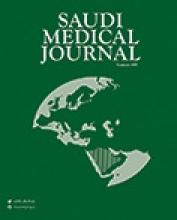Abstract
OBJECTIVE: To assess whether a simple protocol used in the outpatient’s asthma clinic was effective in reducing emergency room (ER) visits and hospitalizations in chronic asthmatics during a year of follow-up, and to evaluate which type of asthmatics, according to severity of asthma, may benefit more from the protocol.
METHODS: Prospective assessment of a simple protocol (consisted of combined medical and educational aspects in the form of corticosteroids inhalation as a monotherapy and correction of the pitfalls of inhalation technique) in reducing ER visits, and hospitalization in chronic asthmatics. It was performed in the outpatients asthma clinic at King Abdul-Aziz University Hospital, Jeddah, Kingdom of Saudi Arabia. A total of 128 chronic asthmatics were evaluated and followed up for one year between January 1999 and March 2000.
RESULTS: Between January 1999 and March 2000 the total number of ER visits, and hospitalizations in 128 chronic asthmatics in the year before the protocol were 269 and 85. This was reduced to 116 ER visits and 27 hospitalizations a year after the protocol, a 55.4%, and 68.2% reduction. While only 25% never attended ER before the protocol, almost 58.6% did not attend ER after the protocol. The proportion that visited ER more frequently (at least 3 times/year) decreased from 50.8-18%, a 65% reduction. Similarly, patients who did not require hospitalization increased from 62.5% up to 85.2%. Moreover, the proportion that was hospitalized more frequently (at least 3 times/year) decreased from 10.2% to as low as 0.8%. Mean paired differences for ER visits were -1.16 ± 1.42 with 95% confidence interval extending from -1.412 to - 0.916 with a P value <0.001. Mean paired differences for hospitalization were -0.453 ± 0.955 with 95% confidence interval extending from -0.620 to -0.286 with a P value <0.001.
CONCLUSION: A simple protocol in outpatient’s asthma clinic can significantly reduce ER visits and hospitalizations in chronic asthmatics. All asthmatics, irrespective of severity benefited significantly from the protocol.
- Copyright: © Saudi Medical Journal
This is an open-access article distributed under the terms of the Creative Commons Attribution-Noncommercial-Share Alike 3.0 Unported, which permits unrestricted use, distribution, and reproduction in any medium, provided the original work is properly cited.






